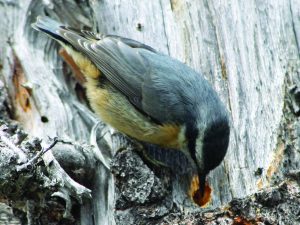BY HARRY WEEKES
 In the second week of September, a small group of students, one more leader, and I backpacked from Pettit to Alice to Toxaway to Imogene to Hell Roaring-—one of the iconic loops in the Sawtooth Wilderness. There were multiple elements of the trip: contemplating the importance of wilderness in the American mind and to the American identity; mulling over the impact and power of place; and safely challenging everyone’s comfort zones, physically, mentally and emotionally. The birds were a bonus.
In the second week of September, a small group of students, one more leader, and I backpacked from Pettit to Alice to Toxaway to Imogene to Hell Roaring-—one of the iconic loops in the Sawtooth Wilderness. There were multiple elements of the trip: contemplating the importance of wilderness in the American mind and to the American identity; mulling over the impact and power of place; and safely challenging everyone’s comfort zones, physically, mentally and emotionally. The birds were a bonus.
A wonderful element of backpacking is the way it strips down the day. Our job was simple: walk from point A to point B, make sure we had enough food and water, and ensure that we took care of ourselves and our group to make it from Day 1 to Day 4. This left all sorts of time for contemplation, rumination, and general mulling. One of the ideas that rolled around in my mind was a growing appreciation for something emerging and increasingly evident in my relationship with birds—what I don’t know.
It is as though my understanding has reached a point where the landscape of my ignorance is opening up. It is cresting Imogene Pass from the Edith basin and thinking, “Whoa… this is what I don’t know.” And instead of being terrified, there is a powerful and positive energy and momentum that feeds curiosity. What is that bird around Alice that wasn’t quite singing, but rather seemed to be talking melodically? And the rattling of the kingfisher at Hell Roaring—why do they do that when they fly? I almost always see them alone; is there some hidden bird or birds I do not see? And the grouse eating the pine nuts on Sand Mountain Pass, the one that left intact seeds that, when opened, were almost all dried up or mealy? How can it tell?
I point out the birds because I want students to see them. I want their concept of and appreciation for this area to include as much of the flora and fauna as possible—from an osprey cruising over Toxaway to the softness of the needles of subalpine fir to the squeaking of the pika (the “koala mouse,” as the students dubbed it). There are flashes of deeper conversation—the osprey’s ability to move on the wing will enable it to respond to warmer years much better than the pika, one of our species that will find its inability to migrate through valleys may consign it to extinction.
Invariably, though, the talk is not as deep as that, and the questions lead to something else, a response that goes like this: “What a great question. I have no idea.” I don’t actually know why the red-breasted nuthatches suddenly showed up at Hell Roaring. Or if the dark morph red-tailed hawks we saw are related, a breeding pair, or even if they were red-tails. In some ways, then, I want to introduce students to comfortable ignorance. To not knowing. To understanding that even as you learn deeply about a thing, or a place, or a person, there can be a simultaneous and increasing mystery.
I wonder if there is some other truth to this, too; we need to know enough before we can really explore, be creative, and be vulnerable. Perhaps it’s aging that has given me this perspective. In the Sawtooths, the birds were the ones that helped me recognize it.
Harry Weekes is the founder and head of school at The Sage School in Hailey. This is his 47th year in the Wood River Valley, where he lives with his wife Hilary and their three kids—Georgia, Penelope and Simon—a nice little flock.


